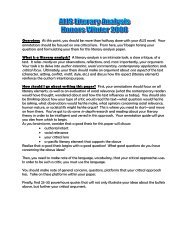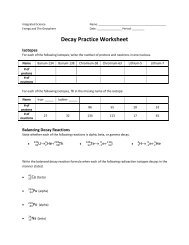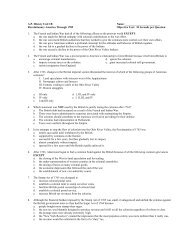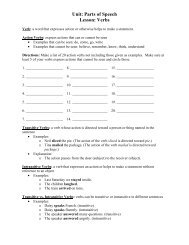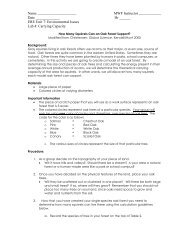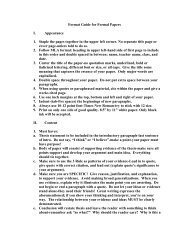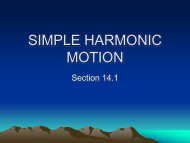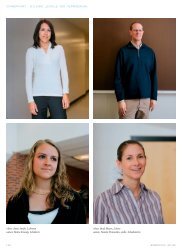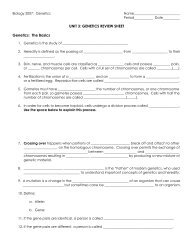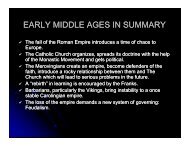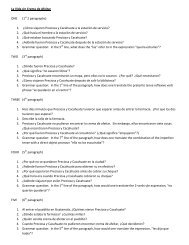Phylum Echinodermata - Arapahoe High School
Phylum Echinodermata - Arapahoe High School
Phylum Echinodermata - Arapahoe High School
Create successful ePaper yourself
Turn your PDF publications into a flip-book with our unique Google optimized e-Paper software.
<strong>Phylum</strong> <strong>Echinodermata</strong>
The Basics<br />
• Symmetry<br />
▫ All echinoderms<br />
have pentaradial<br />
symmetry<br />
▫ BUT… they develop<br />
from bilateral larvae<br />
• Body Openings<br />
▫ Two, mouth & anus
Classifying Characteristics<br />
All echinoderms share several characteristics:<br />
• Endoskeleton made of plates called ossicles.<br />
▫ Ossicles attached to spines or spicules protruding through the skin.<br />
▫ Enchinoderm = “spiny skin”<br />
• Water Vascular System<br />
▫ Network of water-filled canals inside body<br />
• Tube Feet<br />
▫ Small extensions of the water vascular system<br />
• Aid in – feeding, movement, respiration, excretion<br />
• More closely related to Chordates than other Invertebrates<br />
▫ Develop as deuterostomes rather than protostomes<br />
▫ Larva develop with bilateral symmetry
Reproduction & Feeding:<br />
• Echinoderms reproduce sexually, with<br />
both external fertilization & development.<br />
• Echinoderms feed in many different<br />
ways:<br />
▫ Carnivores, Filter Feeders, Scavengers, etc.
Classification<br />
7,000 Species, 6 Classes
Class Asteroidia<br />
• Name Means “starlike”: sea stars<br />
• Tube Feet are used in:<br />
▫ Movement<br />
▫ Capturing Prey<br />
▫ Gas Exchange<br />
• Have TWO stomachs – Cardiac<br />
and Pyloric<br />
▫ Digestion occurs in this order:<br />
• Cardiac Stomach – Pyloric<br />
Stomach – Digestive Glands<br />
• Remarkable Regeneration
Sea Lily<br />
Class Crinoidea<br />
• Examples = crinoids<br />
▫ Sea lilies, and feather stars<br />
• Minimal movement<br />
▫ Sea lillies are sessile as adults<br />
Feather Star<br />
Click Picture to See Video
Class Ophiuroidea<br />
Basket Star<br />
• Name means “snake like”<br />
• Examples = basket stars &<br />
brittle stars<br />
• Characterized by long<br />
narrow arms which allow<br />
quick movement. They will<br />
often break these arms off in<br />
order to escape a predator.<br />
Brittle Star
Class Echinoidea<br />
• Name means “spine-like”<br />
• Example = Sea Urchins and<br />
Sand Dollars<br />
Click on the picture to view<br />
Sand Dollar Movement
Class Holothuroidia<br />
• Name Means “water polyp”<br />
▫ When their tentacles are<br />
extended they resemble the<br />
polyp form of some cnidarians<br />
• Examples = Sea Cucumbers<br />
• Live on the sea bottom<br />
▫ Crawl and burrow into soft<br />
sediment<br />
• Hairy Sea Cucumber Clip
Interesting Extras…<br />
• After watching ALL of the video clips, what did you find<br />
interesting?<br />
• Watch this last Planet Earth Clip. What else can you add to the<br />
list?
Importance:<br />
• Major part of food webs<br />
• Very sensitive to environmental changes, used to monitor<br />
changes.<br />
• Food Sources: people consider urchins and cucumbers<br />
delacacies<br />
• Medicine: Sea cucumbers are often used as a healing agent.<br />
• Sea urchins release so many eggs, in fact, that they are often<br />
used to study chordate development.
HW Questions:<br />
1. Explain two reasons why echinoderms, in<br />
spite of their radial symmetry and simple<br />
bodies, are more closely related to<br />
chordates than to the rest of the<br />
invertebrates.<br />
2. Starfish are known for their incredible<br />
ability to regenerate. Provide a logical<br />
explanation for why doctors are studying<br />
these abilities so closely.



